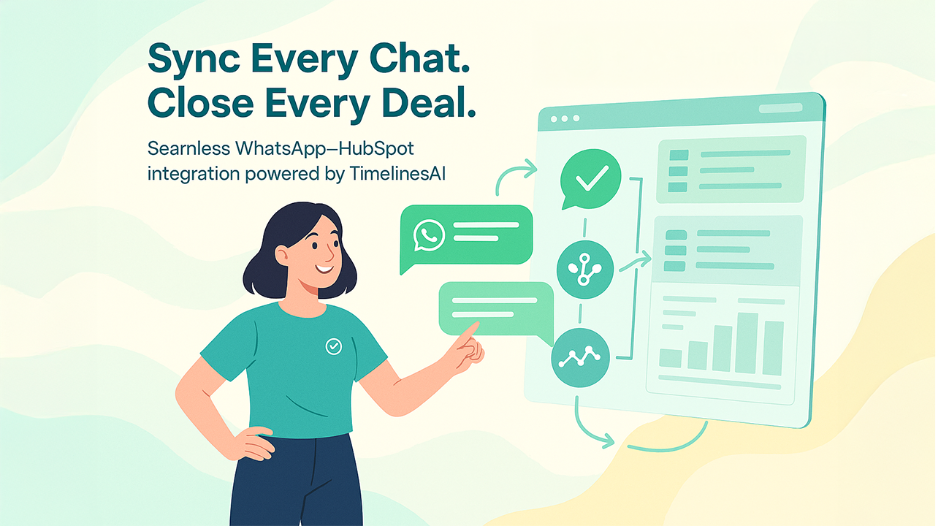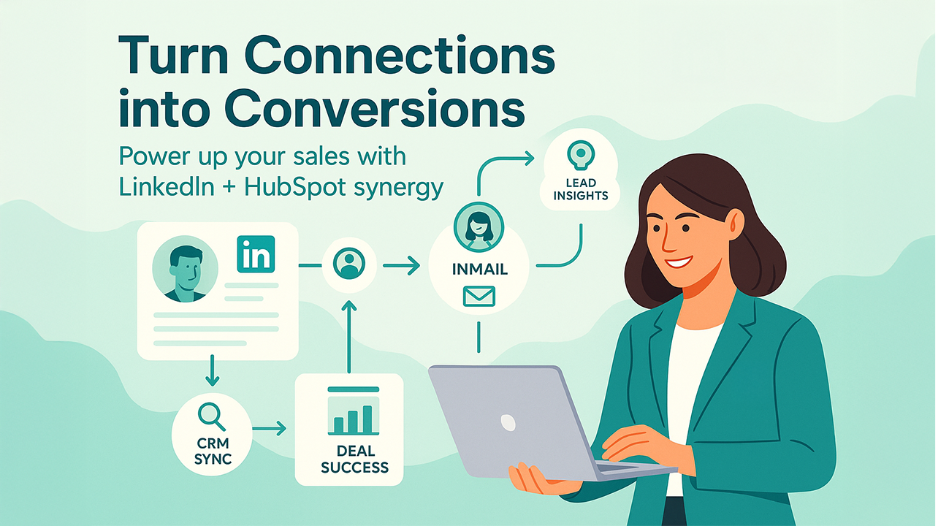With the sales process evolving rapidly in 2026, productivity has become more than just individual performance. Now it is defined by how effectively your tools connect with data. HubSpot ranks as the most powerful CRMs among all. However, to unlock its full potential you must integrate it with the right applications.
Connecting HubSpot to analytics, communication and automation platforms can help streamline workflows, minimize manual labor, and free up your sales team to focus on tasks that matter the most such as fostering relationships and finalizing deals.
Here are five of the best HubSpot integrations every sales-driven organization should use to increase efficiency and revenue in 2026.
1. WhatsApp–HubSpot Integration by TimelinesAI

In the era of instant messaging, WhatsApp is one of the most effective platforms for direct, personalized communication with leads and customers. However, without proper integration, managing WhatsApp conversations separately from HubSpot can cause data fragmentation and missed opportunities.
The WhatsApp–HubSpot integration by TimelinesAI solve this challenge by connecting WhatsApp directly with HubSpot, allowing you to send and receive WhatsApp messages within your CRM. Every conversation is synced automatically with the relevant contact and deal record to constantly ensure full visibility into customer interactions for your sales team.
What really makes this integration powerful is how easily you can set it up, scan a QR code and connect your HubSpot account and in under two minutes texts start syncing. You can use a personal or business WhatsApp account, and for lager teams you can use multiple phone numbers.
You can also build WhatsApp messaging workflows directly into HubSpot. For example, when a deal moves through the stages in the pipeline or when a contact fills out a form, it sends a confirmation code. The TimelinesAI integration means communication can be kept centralized, eliminates the need for manual logging, ensures faster response times and enables teams to provide customers with a seamless experience from the very first chat to someone's final sale. In the age of instant messaging, WhatsApp is one of the best ways to engage customers with one-on-one, personalized communication.
2. Zoom Integration for Effortless Virtual Meetings

Today, video meetings are a necessary part of the sales process, especially for technology-enabled sales forces that are distributed or hybrid. The HubSpot–Zoom integration allows your team to schedule, manage, and track your video meetings directly inside of HubSpot, ensuring every call is properly tracked and every interaction with a lead is captured.
Upon connection, HubSpot automatically creates Zoom links for scheduled meetings and logs all of the meeting details in the contact’s record. After the call, your reps will be able to access attendance data of those who attended the discussion, meeting recordings, and notes without switching tools.
The integration helps save time, but it also allows increased visibility and accountability. Managers can review meeting histories, identify important moments in the sales pipeline, and ensure that any follow-up required actions are completed on time. The Zoom integration also eliminates a communication gap for the remote sales team and lets teams work together more effectively to facilitate collaboration across departments, from marketing to customer success.
Automating meeting workflows will allow your team to shift their focus from administrative work to more engaging prospects, helping you move deals through the pipeline faster than before.
3. Slack Integration for Real-Time Team Collaboration

Speed and responsiveness are critical for closing deals, and that’s where the HubSpot–Slack integration makes a difference. This connection helps flow CRM updates straight into your team’s Slack channels and ensures that everyone stays updated, informed and aligned without having to check HubSpot constantly.
Sales representatives can receive instant notifications about new leads, changes to deal stage and form submissions, while managers can monitor activity and respond to updates in real time. You can also create Slack commands to pull contact or details about any deal from HubSpot, which makes it easier to collaborate during fast-moving sales cycles.
In addition to notifications, the Slack integration also improves communication across all departments. For example, if marketing captures a qualified lead, the sales channel can be notified automatically, allowing immediate follow-up.
This instant communication minimizes delays, increases conversion rates, and creates better teamwork between marketing, sales, and support teams.
By turning Slack into a live extension of your CRM, this integration ensures that important information never gets lost in emails or spreadsheets, empowering your team to act faster and smarter.
4. LinkedIn Sales Navigator Integration for Smarter Prospecting

In B2B business, relationships drive better results, and LinkedIn remains the best platform for building those relationships and connections. The HubSpot–LinkedIn Sales Navigator integration closes the gap between your CRM tools and LinkedIn, which in turn helps sales professionals recognize high-quality leads, connect and nurture them more effectively.
This integration allows sales reps to view details of LinkedIn profile, mutual connections, and recent activity directly within HubSpot contact records. Depending on your existing CRM data, it also offers recommendations and useful insights about leads. It allows you to customize outreach and target decision-makers more accurately.
Sales reps can use InMail and connection requests directly from HubSpot, while all communication is tracked automatically and linked to the respective contact or company. This eliminates tasks of manual data entry and ensures that every LinkedIn touchpoint is recorded in the CRM for future reference.
In the end, this integration allows your team to turn cold outreach into relevant, relationship selling. It is a valuable tool for an account-based marketing (ABM) strategy and in 2026 enterprise sale pipelines.
5. Stripe Integration for Streamlined Payment Processing

Closing a deal is just the tip of the iceberg; getting paid quickly is what keeps your business going smoothly. The HubSpot–Stripe integration helps sales teams simplify the final step of the sales process by enabling payments directly from HubSpot quotes and deals.
When connected, reps can generate payment links, send invoices, and process transactions within HubSpot; no additional tools or manual data transfer required. Each transaction is automatically recorded in the CRM, ensuring that your finance and sales teams stay perfectly aligned.
Beyond convenience, the Stripe integration also improves customer experience. With just a few clicks, clients can make secure payments while providing your team with instant visibility into who has made the payment, whose payment is pending, and which deals have closed.
This integration reduces friction in the sales cycle, accelerates cash flow, and provides valuable financial insights, turning HubSpot into a complete revenue operations hub from prospecting to payment.
Final Thoughts
In 2026, the success of sales is defined by how well your systems connect, sync, automate, and empower your team to make faster decisions and act on them quickly. HubSpot’s ecosystem of integrations makes it all possible, transforming your CRM into a unified command center for communication, discussions, payments, and data.
These combined integrations will save your sales team hours every week while facilitating a smarter, smoother, and more profitable customer lifecycle from start to finish.


